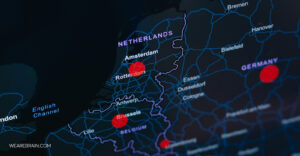Understanding the metaverse and its future iimpact

Dive into the metaverse’s evolving landscape, examining its definition, current platforms, potential impacts on various industries, and the future implications of this digital universe.
Key takeaways
- Metaverse overview: A digital universe combining VR, AR, AI, and more, offering immersive, interconnected experiences beyond traditional internet capabilities.
- Not one, but many: The metaverse consists of both centralized and decentralized platforms, with examples like The Sandbox and Decentraland leading the way.
- Industry impact: Gaming, retail, education, and hospitality are already experiencing transformations through metaverse technologies.
- Future prospects: The metaverse promises a shift towards NFT-based economies, decentralized financial ecosystems, and immersive brand engagements.
- Collaborative opportunities: Brands and businesses are encouraged to explore the metaverse for innovative ventures and customer interactions.
Background
Perhaps the biggest buzzword in global tech, business, and finance, the ‘metaverse’ has recently garnered considerable worldwide attention from everyone: business leaders and CEOs right through to your grandmother.
Facebook’s rebranding of itself into Meta marked a significant shift in the Silicon Valley powerhouse’s focus for the future – and other major tech players and businesses are following suit.
With Microsoft, Google, and Apple also investing massive amounts into the metaverse, it is no wonder that the metaverse is touted to be an $80 billion market by 2024. This will no doubt be further bolstered by the recent news that Qualcomm has announced the launch of a $100 million fund aimed at virtual reality (VR) and augmented reality (AR) technologies to jumpstart the metaverse. Furthermore, Gartner predicts that 25% of people with spend time in the metaverse for entertainment, shopping, work, social media and education by 2026.
But what is the metaverse exactly and what does it mean for our future society?
What is the metaverse?
It is easier to think of the metaverse in terms of how we described the internet during its infancy in the 70s and 80s. A new way of interconnected information and communication was being created slowly and nobody quote knew exactly what it would look like or how it would work. But here we are today, a digitally savvy interconnected global society benefitting from the internet that is reshaping our world every day.
The same is for the metaverse: it is certainly the ‘next internet’ but at this stage, nobody is fully aware of what it will look like when fully embraced by society. But we have a window into its early stages of development and this is what we know so far:
The metaverse is marking a broad shift in how we interact with technology. Like a 3D internet or cyberspace, it is a shared virtual space where physical and digital virtual realities converge. It is made possible by technologies such as virtual reality (VR), augmented reality (AR), head-mounted displays (HMDs), the internet of things (IoT), artificial intelligence (AI), spacial technologies, and 5G. However, it is device-independent, meaning that it exists constantly whether you are in the metaverse or not.
There is no single one metaverse
The metaverse is not owned by a single vendor, and uses a virtual digital currency and non-fungible token-enabled economy.
Currently, the metaverse refers to an open digitally-enhanced virtual space where users can work, play, and socialise through a personalised avatar. Think of it like a video game where instead of quests, users live their virtual lives as they usually do online but through an increasingly more immersive experience.
It is easier to refer to the metaverse as we do with the Internet. It is a type of virtual space (verse/universe) that will welcome users much like social media platforms have done in Web 2: creating an online profile and interacting with other profiles, etc. but this time it is in immersive 3D environments. As such, there will be multiple metaverses available for users to interact within. It is important to be aware that the term ‘metaverse’ refers to a virtual open space itself.
Popular metaverse platforms
Currently, there is an important distinction between metaverses: centralised and decentralised. This just means that centralised metaverses are owned and operated by a business, which implies that all data and assets users own are also controlled by this entity. Decentralised means that there is no single owner, and users interact with it through a public blockchain wallet.
Small break: What is the blockchain?
Web3 decentralised metaverses
One of the most popular metaverses currently, The Sandbox is an Ethereum-based gaming metaverse where users can create, sell, use, and monetise their own virtual reality NFTs. Visually, it is very much inspired by the widely known video game, Minecraft. It uses its native crypto token, SAND, to power the in-game economy.
The Sandbox has become popular with a slew of celebrities and companies purchasing virtual land to build experiences or just own digital real estate. Recently, HSBC purchased NFT land in The Sandbox metaverse, joining other high profile signings including Warner Music, Snoop Dogg, Adidas and Ubisoft games.
Another popular metaverse running off the Ethereum blockchain, Decentraland allows users to buy and sell digital real estate while also playing games and interacting with other users in its virtual world. The metaverse platform allows for interactive apps and in-world payments using two different tokens for different purposes. LAND NFTs are used to facilitate the buying, selling, and proof of ownership of digital land, and MANA is the in-world cryptocurrency used to underpin the purchase of LAND and other virtual goods and services in Decentraland.
Cryptovoxels is another Ethereum-based virtual world that allows users to purchase items and land parcels using the Ethereum cryptocurrency. The metaverse is built to resemble the real world with streets and building infrastructure which users are able to purchase and build anything they like within. Users can even rent their land parcels out to other users, add or remove blocks, and embed audio, video, and images on their land parcel.
Somnium Space allows users to create fully independent, customisable and programmable VR experiences within its connected world. The Ethereum-based metaverse has an NFT marketplace where users can buy, sell and trade game-based assets. By integrating blockchain technology, users can monetise their VR experiences to create a world in their own image.
Centralised metaverses
Meta’s (previously Facebook) Horizon Worlds is a social VR application that allows users to create and explore virtual worlds in an interactive manner. Users engage with both content consumption and creation. The virtual world has ready-to-use VR building components, animation effects and sounds to help users create: over 10,000 worlds have already been created by over 300,000 users to date. It also allows users to play games with each other and interact.
Roblox is an online platform and storefront where users are able to select and play online games made by other users. So, the fun of Roblox is that you can enjoy playing games made by other creators or you can take a turn at creating your own. The platform boasts over 200 million user-generated online games. And brands are getting in on this: Nike has created Nikeland, a virtual space based on Nike’s real-world headquarters for users to connect, create and share experiences through the use of Nike’s game creation tools on the Roblox platform.
What is all the hype about?
Well, the impact that the ‘new internet’ will have on society (judging from the original) is going to understandably be a game-changer for how we live our lives. The internet was first script/text-based, then visual media (images and videos) was incorporated. Now, VR and AR will take it to a level of immersion previously dreamed about by futurists.
No doubt, technology companies are generating much of the metaverse hype because they have a vested interest as they will create technologies to augment and enhance our physical and digital reality. But hype aside, the possibilities are seemingly endless thanks to the convergence of these technologies that have radically improved in recent years.
According to Gartner, activities previously siloed into separate environments will soon occur in the metaverse, including:
- Purchasing outfits and accessories for online avatars
- Buying digital land and constructing virtual homes
- Participating in a virtual social experience
- Shopping in virtual malls via immersive commerce
- Using virtual classrooms to experience immersive learning
- Buying digital art, collectables and assets (NFTs)
- Interacting with digital humans for onboarding employees, customer service, sales and other business interactions
The hope is that the metaverse will provide collaborative, consistent, decentralised and interoperable business opportunities and models that will allow companies to drive digital business.
Industries currently benefitting from the metaverse
Gaming
Currently, video games are perhaps the best example of what the metaverse looks like in operation. Games like Fortnite and Minecraft are open-world virtual environments that users experience through a customisable avatar where they are able to interact with other players in real-time and even purchase items like weapons and clothing using the Fortnite currency (obtained by using real money).
The important difference, however, is that in the metaverse users will actually own their items as an NFT and will be able to use them across other metaverses as long as they run on the same blockchain. In this sense, these games are precisely what the metaverse is: an entire online community operating in a shared virtual space/verse interacting, socialising, and buying/selling virtual items.
But there is some confusion around the interoperability of NFTs across metaverses. There are bold claims that all NFTs can work across other metaverses but this currently isn’t the case. Some NFTs can already interoperate across platforms, like images, but when it comes to 3D assets, things get complex. A lot of development goes into 3D assets and some game developers use different elements, meaning that currently, it is very difficult for complex digital assets to interoperate across metaverses. Also, there are IP implications around these assets which cause issues with interoperability.
Retail and fashion
VR and AR are already transforming the way we shop for items online. These technologies create a unique and immersive digital shopping experience where shoppers can virtually try on items and browse catalogues in a virtual space.
The metaverse will enable the retail and fashion industry to take the digital shopping experience to the next level to create immersive interaction where users can virtually walk through shopping malls and clothing stores from the comfort of their own homes.
For example, the Metaverse Fashion Week recently took place in Decentraland, where major fashion brands such as Tommy Hilfiger, Dolce & Gabanna, and Cavalli (to name a few) showcased their Spring 2022 collections. Items were available for purchase as NFT assets which owners could redeem as physical products delivered to their homes.
Education
VR, AR, head-mounted displays (HMDs), the internet of things (IoT), artificial intelligence (AI), spacial technologies, and 5G are allowing for more immersive and interactive learning experiences without the need for infrastructure. The metaverse will allow learners from all corners of the globe to access educational content, thus eliminating hindrances derived from geography, social, cultural, and economic elements.
VR technology has already greatly assisted the teaching of hard skills and job simulations (like flight simulators for pilots), taking these skills to the next level far quicker and at a fraction of the cost. But VR is now also helping to teach soft skills like leadership and resilience during a time of remote learning where businesses are still required to upskill their employees.
Universities across the world are leveraging VR technology to provide remote access to higher education while still providing an immersive learning experience through virtual campuses. The University of South Korea recently held a virtual student entrance ceremony within Minecraft. The sandbox game has an Education Edition which allows teachers and students to interact through the game.
Hospitality
Global hotel chain Hilton has recently turned to VR technology to enhance employee learning and development through interactive and immersive virtual environments. Using the Oculus for Business platform, Hilton team members (from management through to front-line staff) aim to develop hospitality skills in a virtual environment that simulates real-world scenarios to improve services.
What the metaverse future might look like
According to Brian Trunzo, Metaverse Lead at Polygon Studios (creators of NFTs, games, and various metaverse projects for the Ethereum sidechain), “…anything that can become an NFT will become an NFT”.
Retailers could jump on the metaverse NFT bandwagon and begin developing catalogues of NFTs that will exist solely inside the metaverse. This could lead to more branding and marketing opportunities marketed at metaverse users. However, the aftermath of 2021 left many wondering what happened to NFTs, with general interest and sales volume declining sharply. For brands, this is a sign to be careful when investing in new territory.
The Web3 movement will also bring more decentralisation and the proliferation of community-governed ventures called DAOs (decentralised autonomous organisations). The metaverse could also become the place where new communities flourish based on democratic, peer-to-peer accountability. We’ve done a deep dive into what is a DAO and how they could change the way start-ups and businesses are run in a Web3 future.
The future of finance will likely change with the metaverse creating user-generated financial ecosystems that are decentralised. This will lead to interesting opportunities for new ways to redeem virtual to physical finances that will be leveraged by improvements to AR/VR that will change the way finance operates in both the virtual and physical worlds.
The future of the metaverse is inextricably linked to the future of our modern society. We will no doubt see businesses and brands try to leverage the metaverse to impact both the physical and digital world. The convergence of today’s technologies making the metaverse possible will continue to evolve, and so will the promise of the metaverse.
Let’s team up
Are you looking to venture into the business of the metaverse? Our Web3 Venture and Innovation Studio Braveye can help you make your mark in the virtual future.
David Roman
Working Machines
An executive’s guide to AI and Intelligent Automation. Working Machines takes a look at how the renewed vigour for the development of Artificial Intelligence and Intelligent Automation technology has begun to change how businesses operate.







